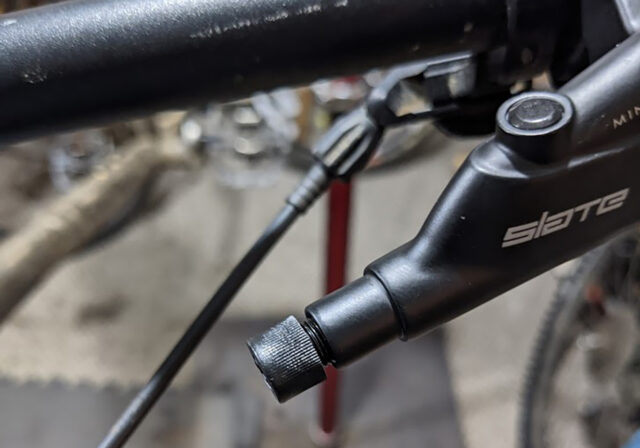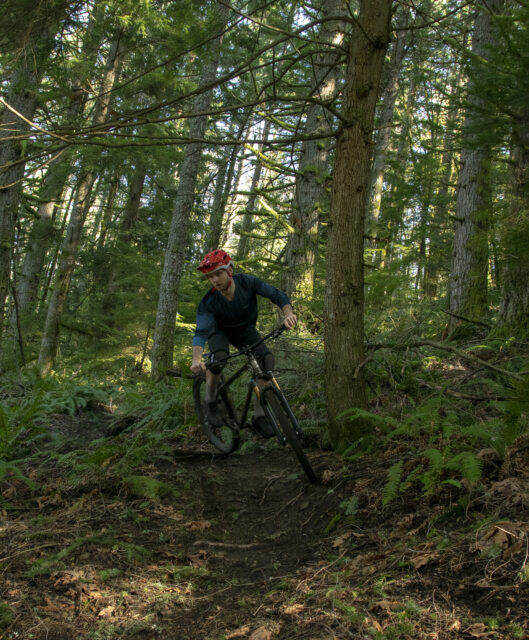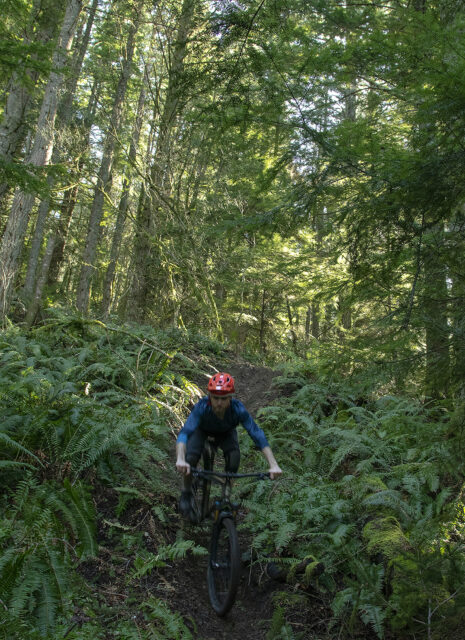TRP Slate T4 Brakes
Blister’s Measured Weight per Brake (uncut hoses, no adapters or rotors): 306 g & 311 g
MSRP: $120 per brake, without rotors or adapters
Bolted to: BTR Ranger
Reviewer: 6’, 165 lbs / 183 cm, 74.8 kg
Test Locations: Washington
Test Duration: 3 months

Intro
TRP’s brakes have garnered a lot of attention in recent years on the World Cup DH circuit under the likes of Aaron Gwin, Marine Cabirou, and Brendan Fairclough. I’ve been testing their Slate T4, which is TRP’s more affordable, four-piston brake aimed at Trail bike use, and think it’s a compelling option for riders looking for a solid performing brake without spending a ton of money.
Design
The TRP Slate T4 has been on the market for a while now, but has seen some updates since its release, and we’ve been spending time on the revised version. The Slate T4’s caliper and lever body carry over from the prior version. It’s still a four-piston caliper, with two 16 mm and two 14 mm pistons per caliper. The larger 16 mm pistons are at the forward side of the caliper, and the idea is that this size disparity evens out the greater wear that usually occurs at the rearward side of the brake pads. Pull a heavily worn set of pads out of a two-piston brake, and you’ll see what I’m talking about. Unless you’re an obsessive bike-tuning maniac (*waves*) and you periodically rotate the pads in your brakes to mitigate this, the rearward side of the pads will almost certainly be worn thinner, due to the rear edge of the pad getting sucked into the rotor as it passes into the caliper.
The Slate T4 caliper features top-loading pad installation, and while that has never been a feature that I’ve personally cared about a whole lot, it can make pad changes quicker and easier. I prefer to take the time to remove the caliper and be a bit more careful about resetting the pistons when swapping pads, but there’s certainly no harm in the Slate’s configuration. Speaking of those pads, they’re the same shape as the Shimano D-type brake pads, as used in all of their recent four-piston brakes (in the versions without cooling fins) — no proprietary pads here. TRP has developed a new organic pad compound, which they say offers faster bedding-in and better heat management than prior versions. These are the stock pads in the Slate T4, and we’ll touch on their performance more below. Semi-metallic and sintered metallic versions are also available.

Moving up to the lever, the newest Slate T4 gets an updated lever blade, which is shared with the new TRP DH-R Evo brake, and was designed with input from Aaron Gwin. It’s got a nicely sculpted hook for secure one-finger braking, and a mix of dimples and perforations for extra grip. The lever blade is a bit longer than average, but I didn’t have any particular issues getting the controls set up for my liking. With most combinations of shifters, dropper levers, and brakes, I find myself running the brake-lever clamp outboard (i.e. nearer to the grips) than the shifter or dropper lever, with a significant gap between both the grips and the brake-lever clamp, and again between the brake-lever clamp and the other controls. The longer lever blade on the Slates meant that I pushed the brake lever clamps in a bit farther than normal, which took away the gap between them and the shifter and dropper post lever, but the overall setup was agreeable.
The Slate T4’s lever features tool-free reach adjustment, but no free-stroke adjustment is to be found. As I wrote in my review of the Hayes Dominion A4, I don’t see that as any great loss, but others may feel differently. There’s also no cam-style device (e.g. Shimano ServoWave or SRAM Swinglink) to increase leverage near the bite point. The simpler design of the Slate T4 lever makes for a smoother, more consistent lever feel throughout the stroke, at the expense of a bit of outright power. The lever clamp is hinged, for easy removal, and uses a single bolt.

While the Slate brakes have always used mineral oil for their fluid, instead of the more caustic DOT, TRP has reformulated the oil they’re using to have lower viscosity and higher temperature stability. The lower viscosity is claimed to make for easier bleeding, as the runnier fluid is less likely to trap small bubbles, and to flow more freely, for a smoother-feeling brake.
TRP also redesigned the hoses used on the Slate. They now have a smaller 5 mm outer diameter, for easier internal routing, as well as increased stiffness, to improve braking power and reduce sponginess in the lever. I haven’t spent time using the prior Slate to compare, but the updated versions do have an impressively firm bite point — often a weak aspect of less expensive brakes — and as we’re about to get into, TRP has put some real thought into making hose routing straightforward.
Setup
While the Slate T4 brake levers aren’t symmetric (to be run on either side of the bar), the Slate T4 comes with the levers not connected to the brake hoses, and full-length hoses for both “front” (i.e., left-hand lever) and “rear” (right-hand) brakes. Prefer to actually run your front-brake lever on the right? No problem.
Despite coming with the levers separated from the hoses, The Slate T4 brakes do come pre-bled, with both the lever and caliper / hose assembly plugged for leak-free setup. And in the most clever touch of all, the plug on the hose is actually a bolt and O-ring that threads into the end of a barb, which comes installed in the hose. TRP calls the system “EZ Plug” and the out-of-the-box configuration is shown below. In the hose photo, the black nub at the end of the hose is the bolt plugging the end of the line; the knurled plastic piece at the end of the lever is also a threaded plug to keep fluid in and air out.


The advantage of the hose plug, in particular, is that the plug is the same diameter as the hose itself, and therefore can be run through an internally routed frame while still sealed off. Normally, the hose needs to be routed with the end of the line open, and prone to dripping fluid and / or taking in air bubbles. My BTR Ranger doesn’t use internal routing for the brake, but this should make for the easiest internal brake routing that I’ve encountered to date. I can certainly confirm that the EZ Plug system was quite simple to work with when connecting the brakes, and that portion of the process would be the same no matter how the hoses are routed.
I was able to just cut and connect the hoses, without needing to do any bleeding right off the bat. I was careful to follow TRP’s instructions, which recommend taking the brake lever off the handlebar after the hose length has been measured, and connecting the hose with the lever pointed up, to keep it from dripping while plugging the hose in. Had I slipped up a little and spilled some oil, a lever bleed likely would have been adequate to get them up and running.
On the Trail
I started with the Slate T4’s stock “Performance Resin” brake pads, my standard 203 mm front / 180 mm rear rotor combo, and hit the trail. As advertised, the resin pads bedded in very quickly and were quiet from the onset. The lever stroke and feel remained consistent, even after extended, brake-dragging descents that introduced enough heat for the brakes’ power to start to fade slightly.
The Slate T4’s lever feel is direct and linear — the closest brake I’ve used in terms of feel is the Shimano XTR Race brake, with the non-ServoWave lever. The Slate T4 has a slightly longer stroke, owing largely to the longer lever blade, but they’re very similar in that they both have a fairly firm bite point, but ramp up to it more gradually than, for example, Shimano’s ServoWave-equipped brakes, or the Hayes Dominion A4. Compared to a SRAM G2 or Code, the bite point is firmer, and the initial stroke a touch lighter / easier.

The shape of the Slate T4’s lever blade is also reminiscent of Shimano’s mid-to-high-end brakes, albeit stretched a bit longer. The cross section of the Slate T4 lever blade is slightly thinner and more rounded than SRAM G2 or Code, or the “standard” lever blade on the Hayes Dominion (Hayes also offers a thinner “Small Finger Lever,” which we have not tested).
With the stock “Performance Resin” pads, the power of the Slate T4 was passable, but relatively low for a four-piston brake — significantly lower than DH-oriented options such as Shimano Saints and Zees, SRAM Codes, or Hayes Dominion A4s, and also somewhat reduced compared to some Trail-focused options, such as four-piston Shimano XTs. In terms of outright power, the Slate T4s compare favorably to the more basic SRAM Guide T, and come close to matching the SRAM G2 RSC.
After a handful of rides, I switched the pads for TRP’s Sintered Metallic option, and they did bump up power appreciably, especially in wet conditions — as is typical for metallic pads. The usual downsides of a metallic pad were present as well. Bed-in time was notably longer, and the metallic pads are a touch noisier than their resin counterparts. I’ve yet to find a brake that I don’t prefer with metallic pads, though, and the tradeoffs with the Slate T4 weren’t any more pronounced than average. Especially living in the Pacific Northwest, the improved wet-weather performance of metallic pads is a bit of a no-brainer for me. If you tend to like resin pads in general, I think you’ll find that TRP’s new Performance versions are pretty good ones; if, like me, you’re firmly on Team Metallic, they’re unlikely to change your mind on that front.

You might have noticed that almost all the brakes I compared the Slate T4s to are more expensive, many of them by a big margin. Retail price for Shimano XT four-piston brakes is $230 per wheel, nearly double the cost of the Slate T4. SRAM G2 RSCs are 50% more expensive, at $180. For a relatively inexpensive Trail brake, the Slate T4 is impressive. They’ve been very reliable and consistent in their performance, and the lever feel is good. Modulation is also a strong suit of the Slate T4 — though it likely costs a little bit of raw power, the lack of a cam mechanism to adjust leverage ratio through the stroke means that the feel is consistent and smooth, without the abrupt ramp-up in power that those systems can introduce. The bleeding process is straightforward, and TRP has incorporated some clever tricks to make initial setup easy, especially on bikes with internal routing. My only complaint is the somewhat middling power, but it’ll be plenty for a lot of people, and especially given the combination of low price and otherwise very good performance, they’re still a promising option for a lot of riders.
Bottom Line
The TRP Slate T4 is a good option for a reliable, consistent Trail disc brake, at a relatively modest price. The outright power isn’t exceptional, but for riders who don’t find themselves needing monster power on their XC or Trail bikes, the Slate T4s will be plenty of brake, and the combination of low price, good consistency and reliability, nice lever feel, and easy setup and maintenance makes them a solid option. They won’t be the brake to sway the DH-brakes-on-Trail-bikes crowd away from their monster stoppers, but for riders who don’t want or need the absolute most powerful brake possible, they’re very good.

I have been thoroughly impressed with these brakes. I replaced the Code R brakes on my Jeffsy with these (and upgraded the rear rotor to 203mm from 180mm) and they have held power super well on long, dusty, Colorado descents. I will definitely be going semi-metallic when the organic pads wear out, but am not really needing more power in our dry conditions. What a steal for $120.